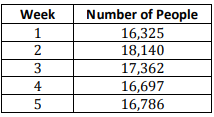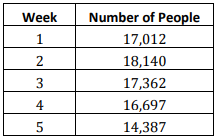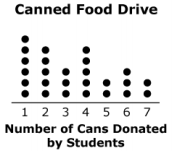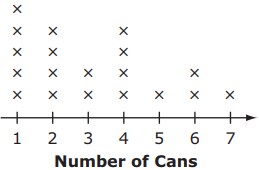General Information
Clusters should not be sorted from Major to Supporting and then taught in that order. To do so would strip the coherence of the mathematical ideas and miss the opportunity to enhance the major work of the grade with the supporting clusters.
Test Item Specifications
- Activity A: Watch the Whales - Determine average speed, distance, and percentage of time at the surface of gray whales.
- Activity B: Time Tally - From observations of a dolphin determine total time and percentage of time of certain behaviors.
- Activity C: Deep Divers - Determine average dive depth, diving time, and surface time of an elephant seal.
- Activity D: Breaches of the Humpback - Graph data and make a prediction from the graph. In this activity, the students will practice problem solving skills to solve complex real-life problems.
Displays should include only dot/line plots, box plots, or histograms.
No
Required
Sample Test Items (5)
| Test Item # | Question | Difficulty | Type |
| Sample Item 1 | Tim drives the Grand Avenue bus route. The total number of people who ride the bus
each week for 5 weeks is shown in the data table.
What is the range of the number of people who ride the bus each week? |
N/A | EE: Equation Editor |
| Sample Item 2 | Alex found the mean number of food cans that were donated by students for the
canned food drive at Epping Middle School. Alex’s work is shown.
How many students donated food cans? |
N/A | EE: Equation Editor |
| Sample Item 3 | Tim drives the Grand Avenue bus route. The total number of people who ride the bus
each week for 5 weeks is shown in the data table.
What is the interquartile range of the data? |
N/A | EE: Equation Editor |
| Sample Item 4 | A dot plot shows the number of cans students at Epping Middle School collected for
a canned food drive.
Select all the options that describe the best measure of center to represent the data in the dot plot.
|
N/A | MS: Multiselect |
| Sample Item 5 | A line plot shows the number of cans a class of students at Epping Middle
School collected for a canned food drive.
How many students collected cans of food? |
N/A | EE: Equation Editor |
Related Courses
Related Resources
Formative Assessments
| Name | Description |
| Quiz Mean and Deviation | Students are asked to calculate measures of center and variability, identify outliers, and interpret the meaning of each in context. |
| Florida Lakes | Students are given a histogram and are asked to describe the variable under investigation and the number of observations. |
| Select the Better Measure | Students are asked to select the better measure of center and variability to describe each of two distributions of data. |
| Analyzing Physical Activity | Students are asked to calculate measures of center and variability, identify extreme values, and interpret the meaning of each in context. |
Lesson Plans
| Name | Description |
| Voter Task Force | Students will help the Supervisor of Elections determine which voter registration locations could be improved to help more citizens get registered to vote. Students will learn about the number of citizens who registered to vote in a general election year compared to the total population of those eligible to vote. They will discuss which voter registration locations will provide the most access to citizens and allocate funds to help address the issue in this modeling eliciting activity. Model Eliciting Activities, MEAs, are open-ended, interdisciplinary problem-solving activities that are meant to reveal students’ thinking about the concepts embedded in realistic situations. Click here to learn more about MEAs and how they can transform your classroom.
|
| Sea Ice Analysis Grade 6 | The changing climate is an important topic for both scientific analysis and worldly knowledge. This lesson uses data collected by the National Snow and Ice Data Center to create and use statistical analysis as a tool to evaluate the mean and variation from the mean of sea ice loss. |
| Sensoring Data | In this follow up lesson, students will explore data collection using the weather station sensor and perform statistical analysis of the data. Students will use a scientific method of inquiry to plan an investigation of their own. This activity is meant to allow students to use a variety of skills they have acquired throughout a statistics unit in a personally meaningful way. |
| Measurement and Data Collection | In this interdisciplinary lesson, students will practice the skill of data collection with a variety of tools and by statistically analyzing the class data sets will begin to understand that error is inherent in all data. This lesson uses the Hip Sciences Sensor Wand and Temperature Probe. Please refer to the corresponding Hip Science Sensor Guide(s) for information on using the sensor. |
| Cool Special Effects | In this MEA, students will apply the concepts of heat transfer, especially convection. Students will analyze factors such as temperature that affect the behavior of fluids as they form convection currents. Model Eliciting Activities, MEAs, are open-ended, interdisciplinary problem-solving activities that are meant to reveal students’ thinking about the concepts embedded in realistic situations. Click here to learn more about MEAs and how they can transform your classroom. |
| Measurement Data Error | In this interdisciplinary lesson, students will practice the skill of data collection with a variety of tools and by statistically analyzing the class data sets will begin to understand that error is inherent in all data. |
| Measurement and Data Collection | In this interdisciplinary lesson, students will practice the skill of data collection with a variety of tools and by statistically analyzing the class data sets will begin to understand that error is inherent in all data. This lesson uses the Hip Sciences Sensor Wand and Temperature Probe. Please refer to the corresponding Hip Science Sensor Guide(s) for information on using the sensor. |
| Preventing Lake Erosion | How can you save your house on the lake? This is a three-day activity that will reinforce science skills, math skills, and technology skills by taking the students through the design process to create a solution to the real-world problem of lake erosion. |
| Crash Test Dummies | Students will investigate inertia and Newton's laws of motion by completing an engineering challenge. Students will first investigate how mass affects the inertia of a person riding in a car that comes to a sudden stop. After analyzing the data and discussing the results, students will be asked to design a seat belt that will keep their clay person in the car without sustaining an "injury." |
| The Penny Lab | Students will design an investigation to collect and analyze data, determine results, write a justification and make a presentation using U.S. pennies. Paired student teams will determine the mass of 50 U.S. pennies. Students will also collect other data from each penny such as minted year and observable appearance. Students will be expected to organize/represent their data into tables, histograms and other informational structures appropriate for reporting all data for each penny. Students will be expected to consider the data, determine trends, and research information in order to make a claim that explains trends in data from minted U.S. pennies. Hopefully, student data reports will support the knowledge that the metallic composition of the penny has changed over the years. Different compositions can have significantly different masses. A sufficiently random selection of hundreds of pennies across the class should allow the students to discover trends in the data to suggest the years in which the composition changed. |
| Sensoring Data | In this follow up lesson, students will explore data collection using the weather station sensor and perform statistical analysis of the data. Students will use a scientific method of inquiry to plan an investigation of their own. This activity is meant to allow students to use a variety of skills they have acquired throughout a statistics unit in a personally meaningful way. |
| Grapevine Fabrication Part 2 | This lesson is a Follow Up Activity to the Algebra Institute and allows students to collect data to perform basic statistical operations to analyze and make comparisons on variability within a certain brand of raisins. Part 1 must be completed prior to starting Part 2. This investigation can elicit discussion about manufacturing and quality control. |
| Grapevine Fabrication Part 1 | This lesson is a Follow Up Activity to the Algebra Institute and allows students to collect data to perform basic statistical operations to analyze and make comparisons on variability within a certain brand of raisins. Part 1 may be completed without Part 2. This investigation can elicit discussion about manufacturing and quality control. |
| Fun with Surveys: An Activity with Number Sets | In this activity, students will circulate around the classroom obtaining data from fellow classmates. Students will pick their own question that will produce numerical responses. Students will hypothesize the mean, median, and mode, calculate the measures, and identify which measure most accurately represents the data. |
| Stats Rock: Using Pet Rocks to Find the Mean, Median and Interquartile Range (IQR) | Using pet rocks, the students will determine the mean, median and interquartile range (IQR) of the weights of the rocks. A PowerPoint presentation and YouTube videos will introduce and reinforce the concepts of mean, median, and interquartile range (IQR). |
| The Best Things About Quantitative Measures | Given quantitative measures students will be able to find the all the quantitative measures. |
| Basketball All Star Team | In this Model Eliciting Activity, MEA, students will create a procedure for ranking high school basketball players. Students are given statistics for each player and are asked to recommend the best player to play for an all-star team after determining the free throw, three-point, and field goal percentages. Students write about the procedure used to make their decisions. In a twist, students are given additional data to determine the mean points per game. Model Eliciting Activities, MEAs, are open-ended, interdisciplinary problem-solving activities that are meant to reveal students’ thinking about the concepts embedded in realistic situations. MEAs resemble engineering problems and encourage students to create solutions in the form of mathematical and scientific models. Students work in teams to apply their knowledge of science and mathematics to solve an open-ended problem, while considering constraints and tradeoffs. Students integrate their ELA skills into MEAs as they are asked to clearly document their thought process. MEAs follow a problem-based, student-centered approach to learning, where students are encouraged to grapple with the problem while the teacher acts as a facilitator. To learn more about MEA’s visit: https://www.cpalms.org/cpalms/mea.aspx |
| Speedster | In this activity, students will collect data to compare their reaction time for catching a falling object or to an online stimulus to that of their classmates. Students will collect data for their class, construct a graph to represent the data, and then answer the question, "How good are my reactions compared to other students?" |
| Calculating the Mean, Median, Mode, and Range from a Frequency Chart | This lesson lasts a total of two hours: 15-minute pre-lesson, 90-minute lesson, and 15-minute follow up lesson or homework. Students will need the two worksheets, a mini-whiteboard, a pen, and an eraser. Each small group will need both card sets, a large sheet of paper, and a glue stick. Students will generate responses to a question about favorite computer games and use this data for the lesson. Students will then work collaboratively to display different data and discuss various strategy approaches. |
| Analyzing Data with Bell Curves and Measures of Center | In this lesson, students learn about data sets and will be able to tell if a bell curve represents a normal distribution and explain why a distribution might be skewed. Students will form their own bell curve calculate measures of center and variability based on their data and discuss their findings with the class. |
| Heartbeat in a Box | This lesson teaches how to make a box plot paying attention to what the quartiles mean. Students find resting heartbeat and active heartbeat. They make observations of this data displayed in box plots on the same number line. Students will interpret and make sense of this data, as well. Outliers are introduced, but not calculated, as is the intent of the standards, at this grade level. |
| Be the Statistician | Students will utilize their knowledge of data and statistics to create a question, collect numerical data, and create a display of their data driven by its quantitative measures of center and variability; mean, median, mode, and range. |
| The Survey Says... | Students will work in groups to conduct class surveys, using the results of the survey to calculate various measures of central tendency. |
| Exploring Central Tendency | Students will review measures of central tendency and practice selecting the best measure with real-world categorical data. This relatable scenario about ranking the characteristics considered when purchasing a pair of sneakers, is used to finally answer the age-old question of "When will I ever use this?". |
| Closest to the Pin! | Students will create and analyze real world data while representing the data visually and comparing to a larger sample size. |
| Candy Colors: Figuring the Mean, Median & Mode | In this lesson, students will count candy of different colors and use the data to calculate the mean, median, and mode. Groups of students will work together to share their data and calculate the measures of central tendency again. At the end of the lesson, they will apply their learning to another data collection. |
| Hot, Hot, Hot! Earth Heating Up | Students will explore the concept of the uneven heating of Earth's surfaces by the Sun by collecting and analyzing data. Outside the classroom, students from several classes will record data points to be analyzed collectively to explore rates of heating related to time and material properties for air, water, and soil. Students will use mathematical techniques to help answer scientific questions. |
Original Student Tutorial
| Name | Description |
| Moving MADness | Learn how to calculate and interpret the Mean Absolute Deviation (MAD) of data sets in this travel-themed, interactive statistics tutorial. |
Perspectives Video: Professional/Enthusiast
| Name | Description |
| Mean Data and Striking Deviations in Sea Turtle Research | <p>Dive in and learn about how statistics can be used to help research sea turtles!</p> |
Problem-Solving Tasks
| Name | Description |
| Don’t Spill the Beans! | The purpose of this task is for students to make a hypothesis, and then doing an experiment to test each students hypothesis. Students will collect and record their data, use graphical methods to describe their data, and finally analyze and interpret their results in the context of the activity. |
| Electoral College | Students are given a context and a dotplot and are asked a number of questions regarding shape, center, and spread of the data. |
Student Center Activity
| Name | Description |
| Edcite: Mathematics Grade 6 | Students can practice answering mathematics questions on a variety of topics. With an account, students can save their work and send it to their teacher when complete. |
Teaching Ideas
| Name | Description |
| Stem-and-Leaf Plots | This lesson is designed to introduce students to stem-and-leaf plots as a graphical way to represent a data set. The lesson also reviews measures of central tendency with directions for finding mean, median, and mode are given. This lesson provides links to discussions and activities related to stem-and-leaf plots as well as suggested ways to integrate them into the lesson. Finally, the lesson provides links to follow-up lessons designed for use in succession with the current one. |
| Drops on a Penny (Box-and-Whiskers Graph) | Students collect data, compute measures of central tendency, and create stem-and-leaf plots and box-and-whiskers plots. |
Text Resource
| Name | Description |
| Hitting Streaks Spread Success | This informational text resource is intended to support reading in the content area. Although scientists haven't determined a specific reason why one baseball player's hitting streak improves his whole team's performance, they have observed a very real mathematical pattern. There may be many reasons for the phenomenon, but no one has found them out yet. |
Tutorials
| Name | Description |
| Mean Absolute Deviation Example | In this video, you will see two ways to find the Mean Absolute Deviation of a data set. |
| Find a Missing Value Given the Mean | This video shows how to find the value of a missing piece of data if you know the mean of the data set. |
Video/Audio/Animations
| Name | Description |
| Median and Range Puzzle | Try these interesting median and range challenge problems! |
| Soybean growth rate response to touch | A time-lapse video showing differential growth rates for touch-treated seedlings and control seedlings. This would be appropriate for lessons about plant growth responses to environmental stress and graphing growth rate. Plants were grown in a vermiculite soilless medium with calcium-enhanced water. No other minerals or nutrients were used. Plants were grown in a dark room with specially-filtered green light. The plants did not grow by cellular reproduction but only by expansion of existing cells in the hypocotyl region below the 'hook'. |
Virtual Manipulative
| Name | Description |
| Box Plot | In this activity, students use preset data or enter in their own data to be represented in a box plot. This activity allows students to explore single as well as side-by-side box plots of different data. This activity includes supplemental materials, including background information about the topics covered, a description of how to use the application, and exploration questions for use with the Java applet. |
Worksheet
| Name | Description |
| Splash of Math - SeaWorld Classroom Activity | This resource allows students to assume the role of an ethologist provide 4 activities that challenge students to apply mathematics to solve complex real-life problems: |
Student Resources
Original Student Tutorial
| Name | Description |
| Moving MADness: | Learn how to calculate and interpret the Mean Absolute Deviation (MAD) of data sets in this travel-themed, interactive statistics tutorial. |
Problem-Solving Task
| Name | Description |
| Electoral College: | Students are given a context and a dotplot and are asked a number of questions regarding shape, center, and spread of the data. |
Student Center Activity
| Name | Description |
| Edcite: Mathematics Grade 6: | Students can practice answering mathematics questions on a variety of topics. With an account, students can save their work and send it to their teacher when complete. |
Tutorials
| Name | Description |
| Mean Absolute Deviation Example: | In this video, you will see two ways to find the Mean Absolute Deviation of a data set. |
| Find a Missing Value Given the Mean: | This video shows how to find the value of a missing piece of data if you know the mean of the data set. |
Virtual Manipulative
| Name | Description |
| Box Plot: | In this activity, students use preset data or enter in their own data to be represented in a box plot. This activity allows students to explore single as well as side-by-side box plots of different data. This activity includes supplemental materials, including background information about the topics covered, a description of how to use the application, and exploration questions for use with the Java applet. |
Parent Resources
Problem-Solving Task
| Name | Description |
| Electoral College: | Students are given a context and a dotplot and are asked a number of questions regarding shape, center, and spread of the data. |





